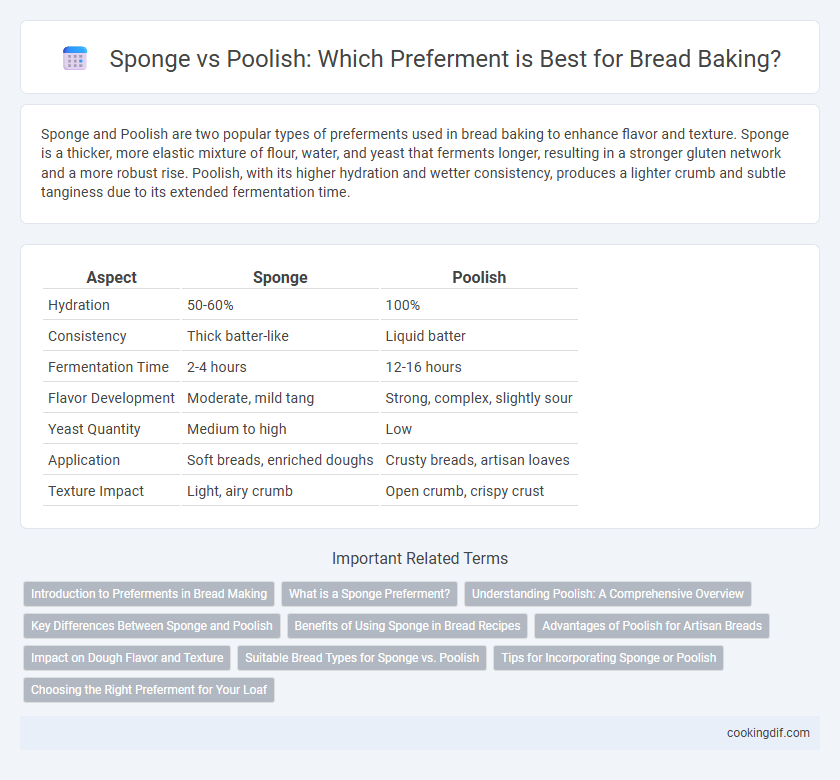Sponge and Poolish are two popular types of preferments used in bread baking to enhance flavor and texture. Sponge is a thicker, more elastic mixture of flour, water, and yeast that ferments longer, resulting in a stronger gluten network and a more robust rise. Poolish, with its higher hydration and wetter consistency, produces a lighter crumb and subtle tanginess due to its extended fermentation time.
Table of Comparison
| Aspect | Sponge | Poolish |
|---|---|---|
| Hydration | 50-60% | 100% |
| Consistency | Thick batter-like | Liquid batter |
| Fermentation Time | 2-4 hours | 12-16 hours |
| Flavor Development | Moderate, mild tang | Strong, complex, slightly sour |
| Yeast Quantity | Medium to high | Low |
| Application | Soft breads, enriched doughs | Crusty breads, artisan loaves |
| Texture Impact | Light, airy crumb | Open crumb, crispy crust |
Introduction to Preferments in Bread Making
Sponge and poolish are two common types of preferments used in bread making to improve flavor and texture. Sponge, a thicker mixture of flour, water, and yeast, ferments longer to develop gluten and a robust taste, while poolish, a thinner batter with equal parts water and flour, offers a lighter crumb and subtle sourness. Both techniques enhance dough fermentation by promoting yeast activity and enzymatic development before the main mixing stage.
What is a Sponge Preferment?
A Sponge preferment is a mixture of flour, water, and yeast that is allowed to ferment before being incorporated into the final dough, enhancing the bread's flavor and texture. It typically has a thicker, batter-like consistency compared to Poolish, which is more liquid and equal in parts flour and water. Using a Sponge preferment improves yeast activity and gluten development, leading to a more open crumb and complex taste in artisanal bread.
Understanding Poolish: A Comprehensive Overview
Poolish is a type of preferment consisting of equal parts flour and water by weight, combined with a small amount of yeast, resulting in a batter-like consistency. It provides improved crumb structure, enhanced flavor complexity, and extended shelf life in artisan bread baking due to its long fermentation period. Unlike sponge, which often has a thicker texture and varies in hydration, poolish's high hydration level promotes enzymatic activity that contributes to a lighter, airier loaf with a slightly tangy taste.
Key Differences Between Sponge and Poolish
Sponge and poolish are both preferments used in bread baking to enhance flavor and texture, but sponge is typically thicker with a consistency similar to batter, containing a higher proportion of flour and yeast. Poolish has a more liquid, batter-like consistency with equal parts water and flour by weight, resulting in a lighter, airier crumb. The fermentation time for poolish is generally shorter, promoting mild sourness, while sponge ferments longer to develop deeper flavors and stronger gluten structure.
Benefits of Using Sponge in Bread Recipes
Using a sponge preferment in bread recipes enhances dough fermentation by promoting better yeast activity and gluten development, resulting in improved texture and volume. The sponge method allows for higher yeast fermentation, which contributes to a complex flavor profile and a more open crumb structure. This preferment also shortens overall dough proofing time, making it ideal for bakers seeking both flavor depth and efficient preparation.
Advantages of Poolish for Artisan Breads
Poolish enhances artisan bread by improving dough extensibility and fermentation, resulting in a more open crumb and complex flavor profile. Its higher hydration level and longer fermentation time promote better gluten development and balanced acidity, crucial for rustic textures. Using poolish also shortens bulk fermentation, increasing dough predictability and consistency in artisan bread baking.
Impact on Dough Flavor and Texture
Sponge preferment enhances dough flavor by developing a complex tanginess due to longer fermentation and active yeast presence, contributing to a robust aroma and chewy crumb texture. Poolish, with higher hydration and yeast activity, promotes a lighter, airier crumb and subtler acidic notes, resulting in a delicate taste and softer texture. Both preferments improve gluten structure but sponge often yields a denser, more flavorful loaf, while poolish favors tenderness and an open crumb.
Suitable Bread Types for Sponge vs. Poolish
Sponge preferments are ideal for denser, heartier breads like rye and whole wheat, enhancing gluten development and fermentation complexity. Poolish suits lighter, airy bread types such as baguettes and ciabatta, promoting a delicate crumb and subtle tang. Both methods improve dough extensibility but cater to different texture and flavor profiles.
Tips for Incorporating Sponge or Poolish
When incorporating sponge or poolish preferments in bread making, maintain hydration levels between 60-100% to promote optimal yeast activity and gluten development. Adjust flour and water ratios in the final dough to compensate for the preferment's moisture content, ensuring balanced dough consistency. Monitor fermentation time closely, as extended proofing with preferments improves flavor complexity but requires precise temperature control to prevent overproofing.
Choosing the Right Preferment for Your Loaf
Choosing between sponge and poolish as a preferment impacts bread flavor, texture, and fermentation time. Sponge, a thicker preferment with a higher flour-to-water ratio, offers a robust yeast activity ideal for denser loaves like sandwich bread. Poolish, a wetter, more liquid preferment, enhances extensibility and aeration, promoting a lighter crumb and a more complex, tangy flavor in artisan-style breads.
Sponge vs Poolish for preferments Infographic

 cookingdif.com
cookingdif.com